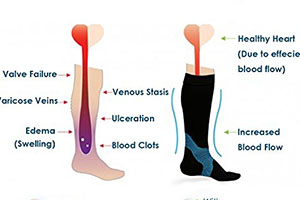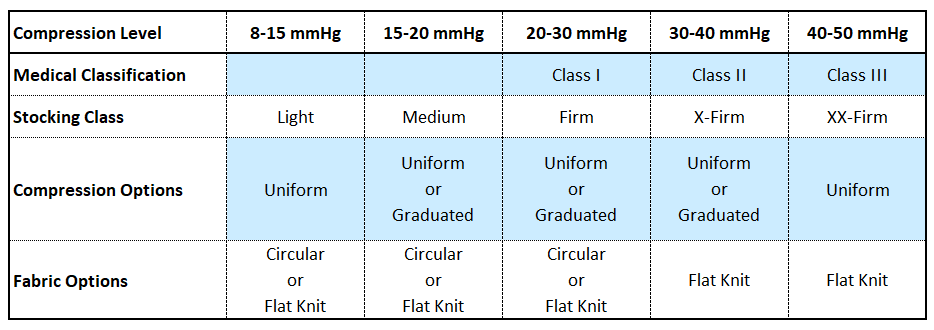Nursing is one of the most stressful jobs! Nurses take great care of us when we need medical attention, but they also carry a lot of responsibilities. Not only do nurses have to deal with hurting patients, but they are also on their feet from the time they clock in until their shift is over.
Long shifts (sometimes 12 hours or more!) can cause leg cramps; muscle fatigue; and tired, achy, sore, swollen calves, ankles and feet. The time they spend on their feet also puts nurses at a high risk of developing varicose veins in their calves and legs (along with many other chronic conditions.)
Fortunately, a growing number of nurses have discovered that compression socks can improve circulation, decrease swelling, prevent varicose veins and make their feet, ankles and legs feel great.
What Are Compression Socks?

Compression socks are specially designed socks do what they sound like–they “compress” the legs. Putting pressure on the legs has been shown to improve blood circulation, help relieve foot stress, prevent certain health issues and minimize the impact venous disorders can have on the bodies of nurses who spend a lot of time on their feet.
These specially designed socks were created to treat medical conditions and have become essential for nurses, athletes and the elderly for whom proper blood circulation is very important.
The best compression socks for nurses are a part of the uniform! They protect their long-term health, enhance comfort, and look great.
Why Do Nurses Wear Compression Socks?
Nurses who are on their feet for long hours and don’t wear compression socks, run the risk of developing serious blood circulation problems, swollen ankles and sore feet. Plus, as compression socks can help reduce fatigue, they can also give nurses that added boost they need to finish a long shift when they are tired.

Compression socks can help to massage the calves, ankles, and feet and help to make the legs feel much more comfortable. These socks can help their tired feet to recover faster and reduce the amount of pain nurses have to endure day after day. And because they promote better circulation, some people feel they enhance oxygen levels in the blood which helps nurses to have more energy and stamina.
Nurses who stand for long periods are more susceptible to varicose veins. The benefits of compression socks are that you can help prevent veins in the legs from becoming enlarged resulting in varicose veins.
In addition, Nurses whose legs swell during or after their workday can help prevent potentially dangerous problems, keep the swelling at bay and help to keep their legs, ankles, and feet healthy by wearing compression socks.
Over the course of a career, a compression sock can make a dramatic difference to a nurse’s health! These socks are a simple, affordable and effective solution to many health problems without being at all invasive.
How Does It Work
Compression socks for nursing professionals work by squeezing the tissue in the legs and helping the blood easier fight against gravity and make its way back to the heart. As nurses get older, the walls of their veins begin to get weaker. This inhibits circulation, hinders the blood from flowing freely and can lead to blood pooling in the legs and lower extremities.
In addition, the squeezing on the legs can help to reduce the pooling of fluid that can often happen in the feet and ankles when people spend a great deal of time on their feet. Compression socks fight against gravity to keep fluid from gathering at the feet and this reduces pain, swelling and discomfort.

Compression socks work with the circulatory system to create a pulse-like action that prevents pooling and enhances circulation. They hold the calves, ankles and feet tightly enough to provide the support they need to help prevent them from becoming inflamed and suffering blood clotting.
Different Levels
Compression socks for nurses come in different levels of pressure and the one you use will depend on your specific needs. Compression levels are measured in millimeters of Mercury (or “mmHg”) – the same type of measurements used in devices for assessing blood pressure.
Compression levels of the socks, stockings, and sleeves range from 15-20 mmHg to 40-50 mmHg or sometimes higher in extreme cases.

Light Compression
- 8-15mmHg – This level of compression is the lowest and is typically sold over the counter. It can be used for light support when traveling.
Medium Compression
- 15-20 mmHG – This level of compression is suitable for daily wear and improves circulation without being too tight. These can typically be purchased over the counter at your pharmacy or online, without a prescription.
Medical Grade
Class I and II Firm Compression
Class I Firm
- 20-30 mmHG – Socks with mid-level compression are ideal for people nurses who have swollen legs or varicose veins, as well as for athletes and others who need a mid-range level of compression. Your doctor may need to write you a prescription for these socks.
Class II Firm
- 30-40 mmHg – For nurses or others who have moderate to severe symptoms of lymphedema, edema, blood clots, and severe varicose veins, the 30-40 mmHg compression level is the best choice. For certain conditions, doctors may prescribe an even higher level, but this is rare.
How to Wear It Correctly
For nurses to get the most out of compression socks, stocking and sleeves, they have to use them correctly.
- Smoothness. This means making sure they are not wrinkled or cuffed when they are worn, so they can be as effective as possible. Cuffs or wrinkles could cause problems with rubbing or chafing the skin underneath the socks, while possibly cutting off circulation.
- Fit. In order to work effectively, compression socks need to be the right size! When purchasing, it is important that you get your calves, ankles, and feet accurately measured to ensure the pair they purchase is the right size.
- Timing. To get the most out of your compression socks, you need to put them on first thing in the morning. This helps to minimize the negative effects that gravity can have on your legs and keeps them in tip-top shape all day long. Keep your compression socks on until bedtime. Or at least until you can get home and put your feet up!
There are a number of excellent reasons nurses should wear compression socks. If their legs feel fatigued after working long hours, compression socks can help alleviate the tiredness and add a spring to their step.
Options
When it comes to compression socks, there are several options from which nurses and other people can choose to get the most benefits. Some nurses have found that the options of knee-high, thigh-high and full-length compression stockings are very effective as well, depending on their health issue and why they are wearing them.
Nurses with painful calves often opt for knee-high compression sock. For nurses who want to promote better blood circulation throughout their entire legs, thigh-high compression stockings are an excellent choice. When they want a compression garment that provides support and prevents swelling through the entire leg, hip and stomach area, waist-high compression pantyhose are what many nurses choose.
Popular Articles on ComproGear
Compression Sock Sizes How to Size Compression Socks
Rose Toy for Women What Does the Rose Toy Do?
Varicose Vein Prevention Best Compression Socks for Varicose Veins
Edema Socks Best Compression Stockings for Edema
Gout Socks Do Compression Socks Help Gout?
Elderly: Compression Socks Easy on Compression Socks for Elderly
Best Compression Socks for Sitting All Day Compression Socks for Desk Job
Prevent and Treat Many Health Issues
Compression stockings do a lot more than soothe and relax tired feet, help stop pain and swelling and prevent varicose veins! Compression socks were designed to treat and prevent many types of medical conditions. Compression socks, stockings, and sleeves have been prescribed by doctors to prevent and treat conditions like blood clots, pulmonary embolisms and more.
People who are pregnant, have heart defects, cardiovascular disease, a high risk of stroke, diabetes, edema or lymphedema or who recently had surgery can get many benefits from wearing compression socks, stocking and sleeves on their legs.
Styles

If you’re thinking that compression socks for nurses only come in that standard white or beige, think again! Support socks for nurses are available in several different styles and colors to match your uniform, scrubs or whatever you’re wearing! There are numerous collections of styles to choose from – plain, prints, themed.
The most common kind or style is still opaque or solid colored compression socks. Suitable for both male and female nurses, the opaque compression socks are comfortable, strong, durable and attractive. Sheer compression socks are also a popular choice because they are lightweight, transparent, fashionable and look great.
Compression socks made of sports grade materials are also available. Made by a high-tech combination of wool, cotton and synthetic materials, these compression socks are durable, effective, long-lasting and come with a moisture wicking feature. Some brand offers wide calf varieties as well.
What is a Support Medical Hose
Some nurses prefer to wear this type of compression garment with their uniforms because they feel it gives them a more professional look while providing the support and compression they need.

You can see nurses wearing compression socks in all types of medical facilities from small, community clinics and doctor’s offices to large, regional medical centers.
Many nurses love these upgraded socks because they are comfortable, effective and look great with their uniforms.
Plus, doctors, co-workers and patients cannot tell them apart from any other type of stockings or socks. Still, no one knows the reason nurses wear them. If it is a personal reason, no one even needs to know that you’re wearing compression socks if you don’t want them to.
A Well-Kept Secret
The widespread use of nursing compression socks in medical facilities nationwide is a well-kept secret among nurses! It’s something they discuss and share with each other because they know the pressures spending so many hours on their feet tending to the needs of patients can put on the legs, ankles and feet.
For older nurses, wearing support compression socks, stockings and sleeves is something that can protect their health and prolong their careers. Many young nurses who have tired feet and sore calves or legs are pulled to the side by an older co-worker and let in on the secret to keeping their legs comfortable and healthy!
In fact, when it comes to the use of compression socks, most experienced nurses feel it’s a necessity if you want to have a long and healthy future in the profession. Nurses have been using compression socks to massage the tiredness out of their legs and keep their blood flowing properly since the garments were introduced in the United States in the 1960s.
While doctors were encouraging patients to use compression socks and support stockings to prevent blood clots, inflammation and swelling in their legs and other health problems, nurses began adopting the garments as part of their own preventative and healing therapy as well.
Choosing The Right Pair
Wearing support compression socks is a great way for nurses to prevent serious health issues, make it easier to perform their daily duties and prevent pain, swelling and stiffness in their calves, ankles and feet by the time their shift is over.
The key to getting the most compression sock benefits is choosing the right pair. There are so many types of compression garments, deciding on the best one can be a challenge.
The best compression socks use every day must be comfortable, soft, lightweight and stylish, fit perfectly, not be too tight or too loose on the calf, be properly reinforced and made of the perfect blend of breathable nylon, spandex, or other durable fabrics.
The ideal pair won’t roll down or constrict the toes, will be durable, moderately thick, have the right level of compression and be suitable for treating and preventing fatigue, swelling, varicose veins and many other serious conditions.
Being affordably priced is the final element that makes a pair of compression socks perfect for any nurse.
If you’re a nurse who is interested in purchasing compression socks but you don’t even have time to get to the store, consider the purchase of compression socks online and have them delivered right to your home! When you work with a company that has your best interest in mind, they’ll offer a 100% satisfaction guarantee on their compression socks, so you just can’t go wrong!
This page last updated December 14, 2022
